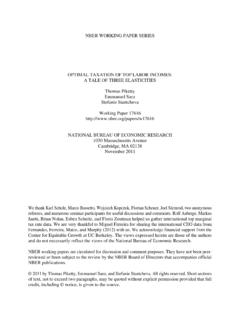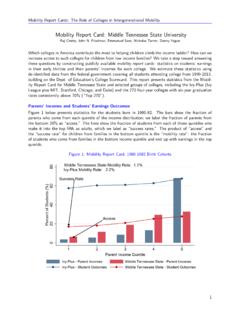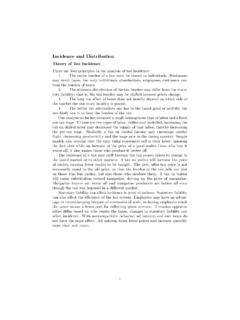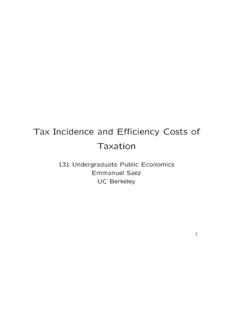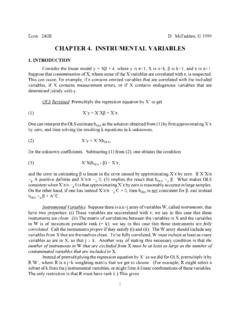Transcription of Journal of Public Economics
1 Optimal minimum wage policy in competitive labor marketsDavid Leea, Emmanuel Saezb, aDepartment of Economics , Princeton University, Industrial Relations Section, Firestone Library A-16-J-1, Princeton, NJ 08544, USAbUniversity of California, Department of Economics , 530 Evans Hall #3880, Berkeley, CA 94720, USAabstractarticle infoArticle history:Received 21 September 2011 Received in revised form 21 May 2012 Accepted 1 June 2012 Available online 9 June 2012 Keywords:Minimum wageOptimal taxationThis paper provides a theoretical analysis of optimal minimum wage policy in a perfectly competitive labormarket and obtains two key results. First, we show that a binding minimum wage while leading to unem-ployment is nevertheless desirable if the government values redistribution toward low wage workers and ifunemployment induced by the minimum wage hits the lowest surplus workersfirst.
2 Importantly, this resultremains true in the presence of optimal nonlinear taxes and transfers. In that context, a binding minimumwage enhances the effectiveness of transfers to low-skilled workers as it prevents low-skilled wages fromfalling through incidence effects. Second, when labor supply responses are along the extensive marginonly, which is the empirically relevant case, the co-existence of a minimum wage with a positive tax rateon low-skilled work is always (second-best) Pareto inefficient. A Pareto improving policy consists of reducingthe pre-tax minimum wage while keeping constant the post-tax minimum wage by increasing transfers tolow-skilled workers, andfinancing this reform by increasing taxes on higher paid workers. Those resultsimply that the minimum wage and subsidies for low-skilled workers are complementary policies.
3 2012 Elsevier All rights IntroductionThe minimum wage is a widely used but controversial policy minimum wage can increase low-skilled workers' wages at the ex-pense of other factors of production such as higher skilled workers orcapital and hence can be potentially useful for redistribution. How-ever, it may also lead to involuntary unemployment, thereby worsen-ing the welfare of workers who lose their jobs. A large empiricalliterature has studied the extent to which the minimum wage affectsthe wages and employment of low-skilled workers (see ,Card andKrueger (1995), Brown (1999),or Neumark and Wascher (2007)forextensive surveys). The normative literature on the minimum wage,however, is much less paper provides a normative analysis of optimal minimumwage policy in a conventional competitive labor market model,using the standard social welfare framework adopted in the optimaltax theory literature.
4 Our goal is to use this framework to illuminatethe trade-offs involved when a government sets a minimum wage,and to shed light on the appropriateness of a minimum wage in thepresence of optimal taxes and part of the paper considers a competitive labor market withno taxes/transfers. Although simple, this analysis does not seem to havebeen formally derived in the previous literature. We show that a bind-ing minimum wage is desirable as long as the government valuesredistribution from high- to low-wage workers, the demand elasticityof low-skilled labor isfinite, the supply elasticity of low-skilled laboris positive, and most importantly, that the unemployment induced bythe minimum wage is efficient, unemployment hits workers withthe lowest surplusfirst.
5 The intuition is extremely simple: startingfrom the competitive equilibrium, a small binding minimum wage hasafirst order positive distributional effect but only a second order nega-tive effect on efficiency as only marginal workers initially lose their second part of the paper considers the more realistic casewhere the government also uses taxes and transfers for redistribu-tion. In our model, we abstract from the hours of work decision andfocus only on the job choice and work participation decisions. Sucha model can capture both participation decisions (the extensive mar-gin) as well as decisions whereby individuals can choose higher pay-ing occupations by exerting more effort (the intensive margin). Inthat context, the government observes only earnings, but not the utilitywork costs incurred by such a model, we show that aminimum wage is desirable if unemployment induced by the minimumwage is efficient and the government values redistribution toward low-skilled workers.
6 The intuition for this result is the following. A bindingJournal of Public Economics 96 (2012) 739 749 Corresponding Saez).1We also show inSection 5that our results extend to a model with variable hours ofwork under the strong and unrealistic assumption that the government can set specificlinear tax rates on each type of labor. As recognized previously (see ,Guesnerie andRoberts (1987)), the theoretical drawback of the model with variable hours of work isthat although the government observes wage rates to impose the minimum wage, itdoes not use this information to design the optimal tax, which creates an informationalinconsistency in the government decision $ see front matter 2012 Elsevier All rights lists available atSciVerse ScienceDirectJournal of Public Economicsjournal homepage: wage enhances the effectiveness of transfers to low-skilledworkers as it prevents low-skilled wages from falling through incidenceeffects.
7 This result can also be seen as an application of theGuesnerie(1981)and Guesnerie and Roberts (1984)theory of quantity controlsin second best economies. When the government values redistributiontoward low-skilled workers, the optimal tax system over-encouragesthe supply of low-skilled labor. A minimum wage effectively rationsover-supplied low-skilled labor, which is socially desirable. Unsurpris-ingly, if rationing is uniform ( , unemployment hits randomly and in-dependently of surplus), then the minimum wage does not revealanything on costs of work and it cannot improve upon the optimaltax/transfer , when labor supply responses are solely along the partici-pation margin, a realistic assumption supported by the empiricallabor supply literature, we show that imposing a positive tax rateon the earnings of minimum wage workers is second-best Pareto in-efficient.
8 Reducing the minimum wage and compensating low-skilledworkers with higher transfersfinanced by extra taxes on high-skilledworkers lead to a Pareto improvement. This result remains true evenif rationing is inefficient. This result is therefore perhaps the moststrikingfinding of the paper and the most policy relevant one. Indeed,many OECD countries, which initially had significant minimum wagesand high tax rates on low-skilled work, have moved in this directionby reducing payroll taxes on low-skilled work and expanding in-workbenefits along the model of the US Earned Income Tax Credit. This re-sult could possibly also be applied to other situations where lowskilled wages are downward are two strands in the recent normative literature on theminimum wage.
9 Thefirst, most closely associated with labor econom-ics, focuses on efficiency effects of the minimum wage in the presenceof labor market imperfections such as monopsonistic competition(Robinson, 1933; Manning, 2003; Cahuc and Laroque, in press), effi-ciency wages (Drazen, 1986; Jones, 1987; Rebitzer and Taylor,1995), bargaining models (Cahuc et al., 2001), signaling models(Lang, 1987; Blumkin and Sadka, 2005), search models (Swinnerton,1996; Acemoglu, 2001; Flinn, 2006; Hungerbuhler and Lehmann,2009), or endogenous growth models (Cahuc and Michel, 1996). Inmany of those situations, a minimum wage can improve efficiency ab-sent any redistributive consideration. These studies are complemen-tary to our analysis that focuses on the equity-efficiency trade-offunder perfect second smaller literature in Public Economics investigates, as wedo, whether the minimum wage is desirable for redistributive reasonson top of optimal taxes and transfers.
10 In contrast to our occupationalchoice model, this previous literature has mostly focused on theStiglitz (1982)model with two skills and endogenous and competitivewages and has found that a minimum wage is in general not helpful tosupplement the optimal nonlinear tax system (Allen, 1987; Guesnerieand Roberts, 1987).2 The Stiglitz (1982)model however focuses solelyon the intensive margin and hence cannot capture the participationelasticity of low-skilled workers that is at the heart of the policy discus-sion and empirical analysis of the minimum wage. We discuss in detailthe reasons for the discrepancy between those earlierfindings and ourfindings inSection 5where we consider a model with variable hours ofwork. As an important caveat, our results only extend to the variablehours of work model under strong and unrealistic assumptions on thetax tools available to the remainder of the paper is organized as 2pre-sents the 3analyzes optimal minimum wage policywith no 4extends the analysis to the case with optimaltaxes and transfers.

